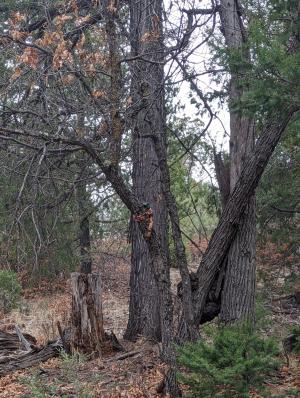Cultural Resources
Tribal cultural resources
Use of fire played a significant role in the land management practices of Native Americans in California and throughout much of the west. Traditional use of fire included, but were not limited to: enhancing food resources (i.e. acorns, nuts, berries, greens), materials (i.e. for basketry, utensils, implements, weapons), travel and safety (i.e. clearance of fuel and vegetation around water sources-springs, along trails, around camps and villages) and for increasing productivity and diversity of vegetation that promoted other valued fungi, plants and wildlife.
Tribes inhabiting the Sierra Nevada’s adapted to and influenced components of natural fire regimes to renew or stimulate habitat to produce these products. When and where lightning ignitions were not adequate to produce desired fire effects, tribes used fire for many purposes. Tribal uses of fire influenced natural fire regimes to be more of cultural fire regimes in some localities of the landscape by changing the frequency, seasonality, intensity, and ignition patterns of fire and modifying fuel loading.
Collection of fuel wood for heating and food preservation also reduced fuel loading and influenced fire behavior around areas of the landscape where tribal subsistence and ceremonial activities took place. This (pre-) European fire use and manipulation of the vegetation and fuels persisted for thousands of years and resulted in changes of forested habitats from otherwise natural conditions. The structure and composition of forests for some areas across the landscape still bear the legacy of former tribal management.
Many of these habitats and forest resources, adapted to fire, are still valued by tribes today. The incorporation of tribal fire related knowledge for organisms, populations, habitats, and areas of the landscape that foster valued cultural resources is important for managers to be aware of and consider. Tribes consider many living natural resources affected by fire as important cultural resources. Managers can gain this fire-tribal cultural resource information by consulting, coordinating, and collaborating with tribes regarding proposed fire and hazardous fuels treatments.
Publications
- S. Hummel, F.K. Lake. 2015. Forest site classification for cultural plant harvest by tribal weavers can inform management
- Frank K. Lake. 2011. Working with American Indian tribes on wildland fires: protecting cultural heritage sites in northwestern California
- Frank K. Lake. 2013. Historical and cultural fires, tribal management and research issues in Northern California: Trails, fires and tribulations
- Frank K. Lake, Jonathan W. Long. 2014. Fire and tribal cultural resources
- Kevin C. Ryan, Ann Trinkle Jones, Cassandra L. Koerner, Kristine M. Lee. 2012. Wildland fire in ecosystems: effects of fire on cultural resources and archaeology
- Ronald L. Trosper, Fred Clark, Patrica Gerez-Fernandez, Frank Lake, Deborah McGregor, Charles M. Peters, Silvia Purata, Teresa Ryan, Alan Thomson, Alan E. Watson, Stephen Wyatt. 2012. North America [Chapter 5]
External Publications
-
Anderson, M.K. 2006. The Use of Fire by Native Americans in California. In: Sugihara et al., eds. Fire in California's Ecosystems: 417-430
-
Kimmerer, R.; Lake, F.K. 2001. Maintaining the mosaic: the role of indigenous burning in land management. Journal of Forestry. 99(11): 36-41.



